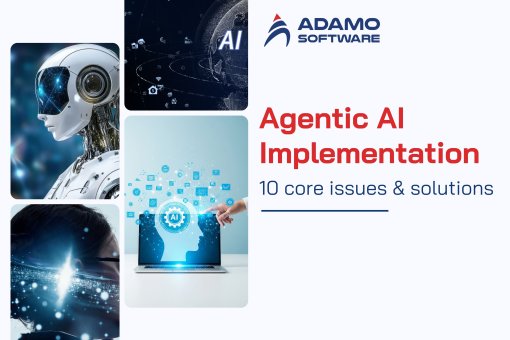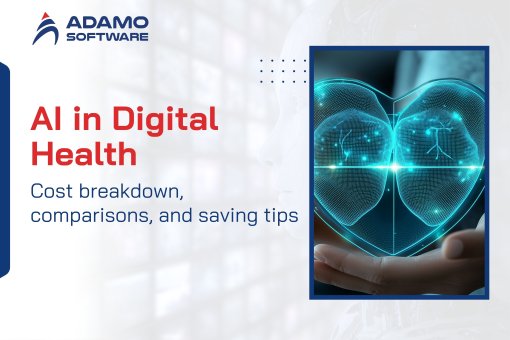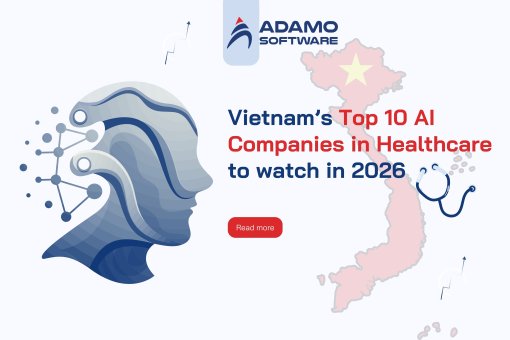AI Image Recognition: The ultimate guide for starters
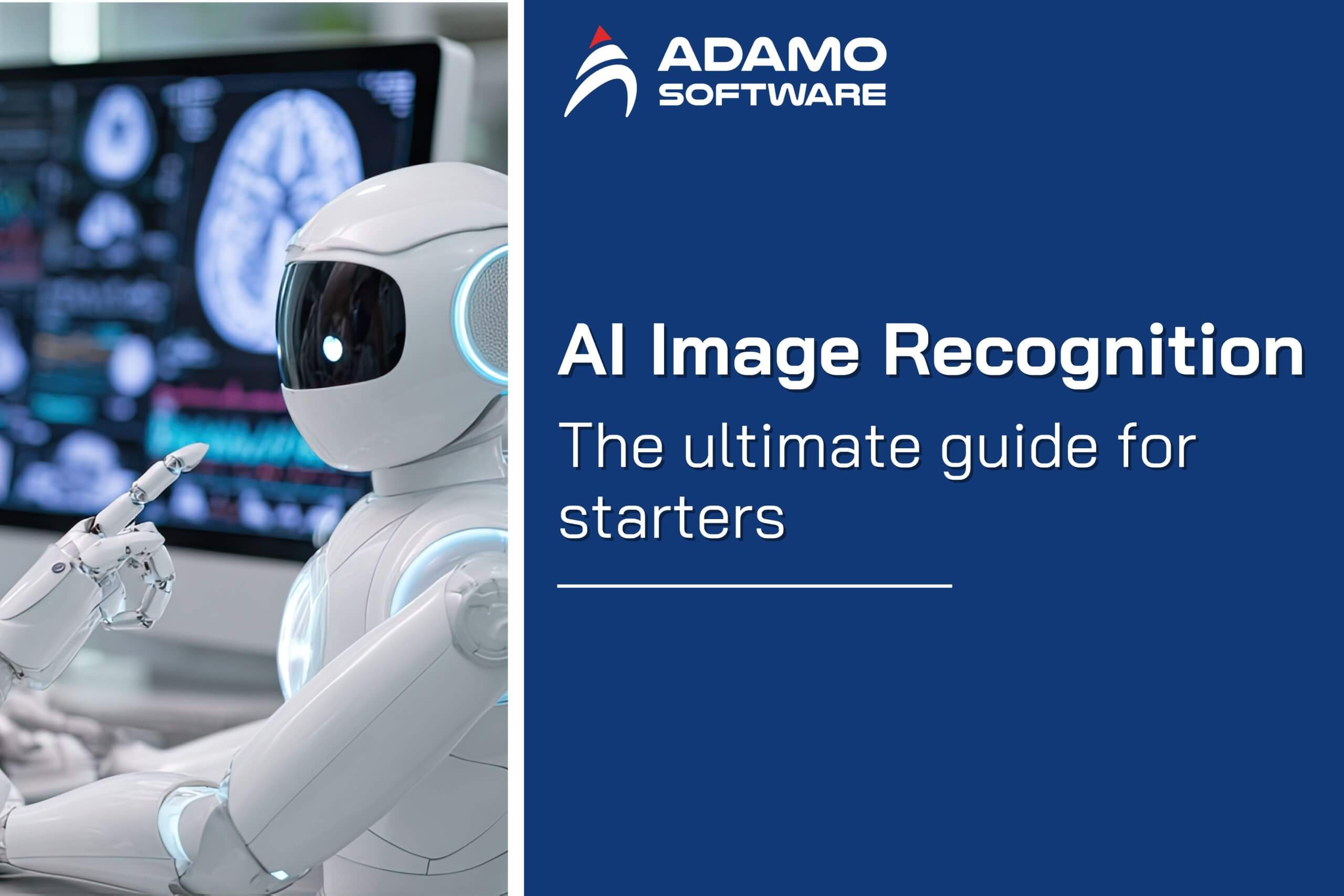
AI image recognition is an adoption of AI in today’s digital world. Let’s learn about this technology with Adamo Software!
Artificial intelligence (AI) plays an important role in today’s digital world. One of the most use cases of this technology is AI image recognition, which is reshaping production across many industries. Let’s learn about this technology with Adamo Software!
Through this blog post, you will find out the following pieces of information.
- What is AI Image Recognition?
- Why should you choose AI-powered image recognition for the first project?
- AI image recognition algorithms for beginners
- AI for Image Recognition: Inference model approaches
- How is AI Image Recognition being used in the real-world?
All of the information has been thoroughly researched and updated to the latest trends. So, if you are new to AI image recognition, read our blog post now!
I. What is AI Image Recognition?
Image recognition is a branch of computer vision that focuses on identifying and classifying images. This technology uses computer vision to gather and organize image data, locate objects captured by digital cameras, enhance images, detect events, and perform other tasks.
Focusing on a narrower set of tasks, image recognition software is designed to identify and analyze images, followed by classifying them into predefined categories and labeling them according to specific attributes. These computer vision systems are typically trained to classify images based on the people, objects, places, or logos within them.
Like other AI technologies, image recognition is experiencing a boom. According to Marketsandmarkets, the AI image recognition size is already exceeding $46 billion and projected to more than double by the end of the decade.
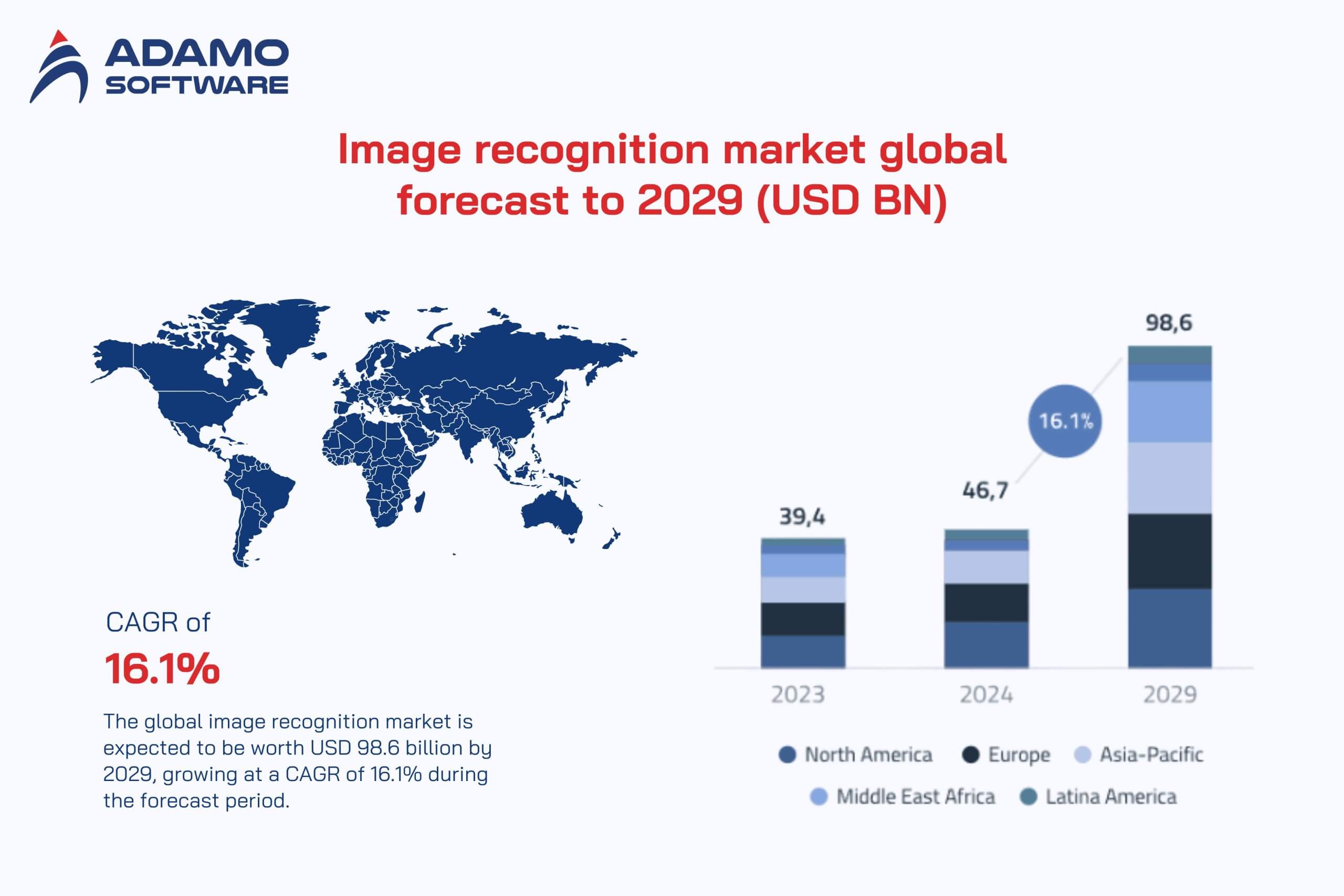
As reported by Grand View Research, the global image recognition market is experiencing robust growth, with a compound annual growth rate (CAGR) of 12.8% from 2024 to 2030, taking its value from USD 53.3 billion in 2023 to a projected USD 128.3 billion by 2030. This growth is primarily attributed to key factors like the increasing volumes of image data, ongoing advancements in AI and ML, and the rising demand for automation in different sectors.
In general, AI image recognition is a field of artificial intelligence that analyzes and classifies images based on various criteria. Today, this technology is considered one of the important trends driving innovation in many fields.
II. Why should you choose AI-powered image recognition for the first project?
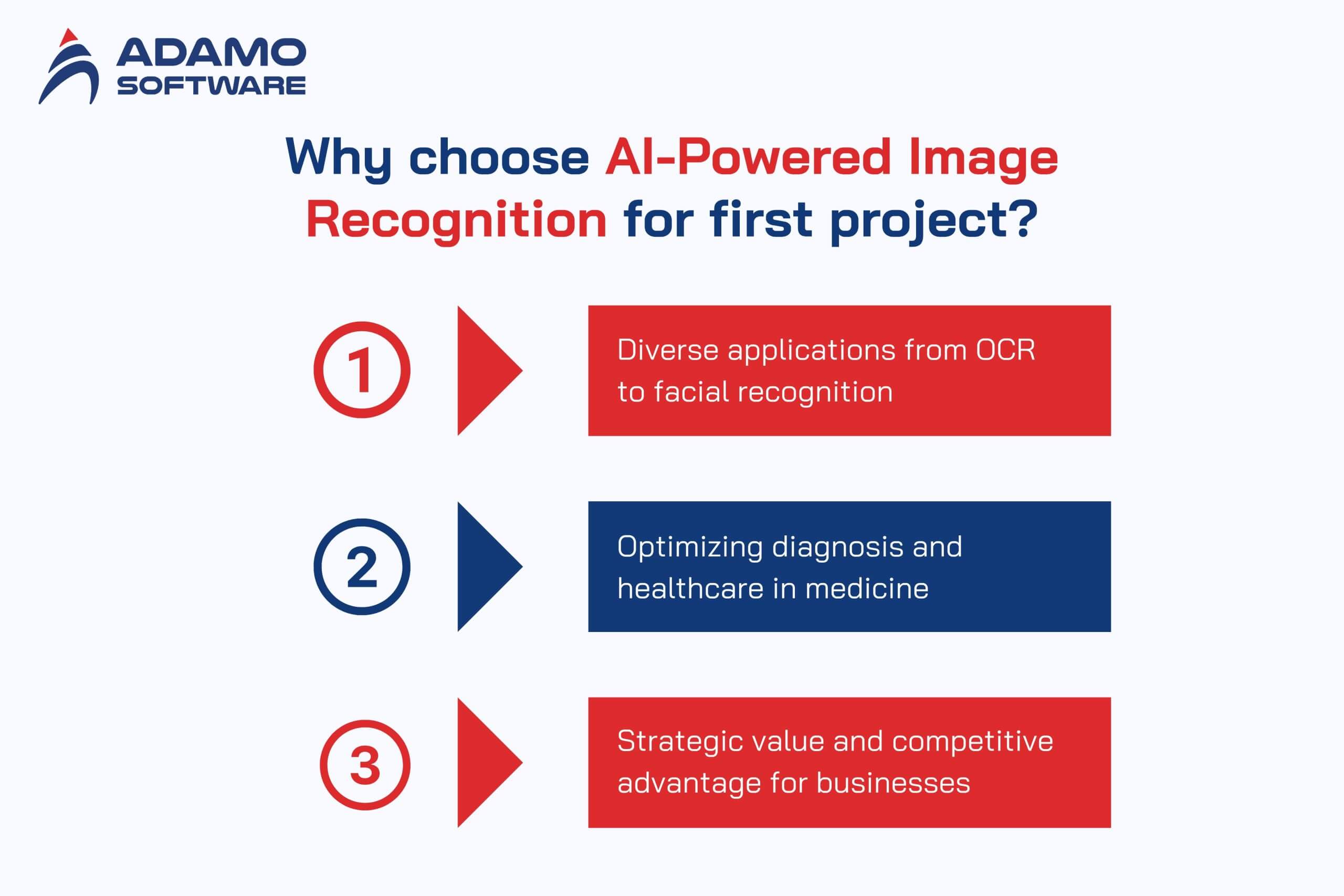
Choosing the AI image recognition technology for your first project brings many benefits in reality. Let Adamo Software discuss why you should adopt this.
- Diverse applications from OCR to facial recognition: Digitalization, security, convenience.
- Optimizing diagnosis and healthcare in medicine: Disease detection, treatment support.
- Strategic value and competitive advantage for businesses: Innovation, efficiency, sustainability.
Let’s learn about each reason in detail!
1. Diverse applications from OCR to facial recognition
One of the reasons for choosing AI image recognition is its diverse applications from OCR to facial recognition. With OCR, businesses can easily digitize documents, saving time on manual data entry. This technology also helps to retrieve information quickly, improving data management efficiency.
Meanwhile, facial recognition technology enhances security and supports quick identity verification. Thanks to this convenience, AI has become the optimal tool for many different fields.
2. Optimizing diagnosis and healthcare in medicine
Adopting AI image recognition helps to optimize diagnosis and healthcare in medicine. With the ability to analyze medical images quickly and accurately, this technology helps doctors detect early abnormalities such as tumors, tissue damage or signs of potential disease. The application of AI can reduce errors in diagnosis and shorten processing time, bringing higher confidence to both doctors and patients.
Besides detecting disease, AI also contributes to optimizing treatment regimens by providing detailed analysis data and comparisons with similar medical cases. This helps doctors make more effective and personalized treatment decisions for each patient. Thanks to this, healthcare facilities can improve the quality of health care significantly, bringing practical benefits to both patients and the health system.
3. Strategic value and competitive advantage for businesses
Strategic value is also one of the important reasons for choosing AI image recognition for your first project. AI not only helps automate processes and reduce labor costs but also improves the accuracy of image data processing. This creates a solid foundation for businesses to build smarter systems, increase operational efficiency, and easily expand applications to other areas in the future.
In addition, bringing competitive advantages for businesses is also a benefit of AI image recognition. Companies applying AI-powered image recognition can provide products and services faster, more accurately and bring better experiences to customers.
Generally, the adoption of AI image recognition brings many practical benefits. Thanks to the ability to automate, reduce costs, increase operational efficiency and improve customer experience, businesses applying AI have the opportunity to innovate, develop sustainably and affirm their position in the market.
Explore Our Tailor-made Software Development Solutions
We are confident in providing end-to-end software development services from fully-functioned prototype to design, MVP development and deployment.
III. AI image recognition algorithms for beginners
AI image recognition algorithms are the core foundation that allows computers to understand the image. Each algorithm plays its own role in improving accuracy and processing efficiency. Here are some algorithms for beginners that you should refer to.
- Convolution Neural Network (CNN): four layers playing different roles
- Single Shot Detector (SSD): object recognition and detection in images
- You Only Look Once (YOLO): process the picture only once
Let’s look at each algorithm in detail.
1. Convolution Neural Network (CNN)
Convolutional Neural Network (CNN) is a deep learning model that specializes in processing and analyzing image data by automatically extracting features through convolutional and pooling layers. This algorithm of the AI image recognition has four layers, including the convolution layer, the relu layer, the pooling layer, and the flattening layer.
The convolution layer utilizes its filter to calculate pixel values and form a feature map. Next, the relu comes into play, setting all negative values within the data to zero. The pooling layer downsamples the data, which diminishes the number of parameters and retains the most significant features. Finally, the flattening layer transforms the results into a single vector, which is then fed into the network’s neurons.
This general model has several variations, such as the Region-based CNN (R-CNN), which first divides an image into thousands of regions and then applies a CNN to each. The main drawback of this algorithm is its long training time of about 84 hours. This can be addressed by the Fast R-CNN algorithm, which reverses the order of operations by splitting the picture into regions after the CNN application.
2. Single Shot Detector (SSD)
SSD is also among the algorithms of the AI image recognition technology. While CNN-driven image recognition systems can create overlapping boxes around image elements, SSD avoids this by dividing the image into default bounding boxes. This grid enables the system to process the image at different aspect ratios and handle objects of various sizes. These algorithms are fast (125 ms per image), accurate, and flexible, and they are reliable during training.
3. You Only Look Once (YOLO)
You Only Look Once (YOLO) is an AI image recognition algorithm that processes the picture only once to determine if an image is within the grid, using a confidence metric and a fixed grid size with multiple bounding boxes. While this approach is incredibly fast, its accuracy is often subpar because it only captures key features instead of digging into the details of multiple aspect ratios.
Typically, an AI image recognition product uses a single core algorithm, but custom models can combine several to boost efficiency. These algorithms can each be leveraged to power a variety of inference AI image recognition models.
IV. AI for Image Recognition: Inference model approaches
For AI image recognition systems to work effectively, in addition to model training, the inference process also plays an important role. Below are the inference model approaches of AI for image recognition.
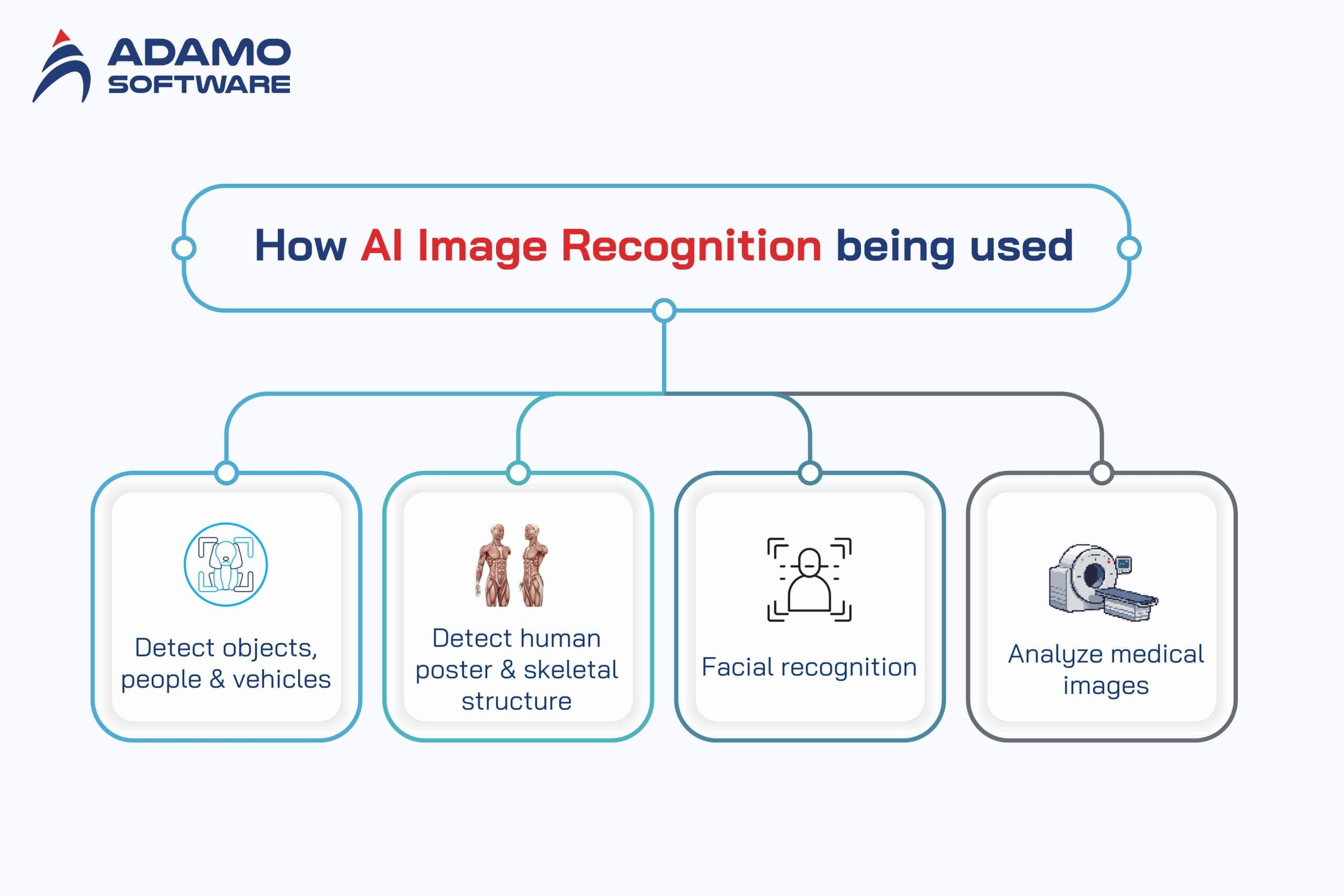
- Detecting objects, people, and vehicles: Visual object recognition
- Detecting human posture and skeletal structure: Gesture and pose recognition
- Facial recognition: Facial recognition and analysis
- Analyzing medical images: Medical imaging
Let’s find out more information about each model approach with Adamo Software!
1. Detecting objects, people, and vehicles
The AI image recognition’s visual object recognition model is trained to recognize objects like objects, logos, people and vehicles in images and live videos. This allows the system to monitor human behavior at work or in public areas. It also helps control traffic congestion and jams on streets and open spaces.
2. Detecting human posture and skeletal structure
During photo and video analysis, these models of AI image recognition scan information about body parts (head, neck, hands, and more), their connections, and joint positions and angles to understand movements and postures. Their applications are wide-ranging, including gesture recognition, fitness tracking, and biomechanics research, as well as anticipating behavioral intent.
3. Facial recognition
Though this model focuses on only one body part, it must be highly precise to capture the minute details and patterns of facial features like the nose, eyes, and mouth. The face detection model is used in authentication and security systems. It identifies a person’s gender, age, ethnicity, and emotions by comparing captured images to a database of previously recorded examples. During the global pandemic, this technology found a crucial application in monitoring public health, as it enabled specialists to detect and record people’s body temperature through thermal video scans.
4. Analyzing medical images
The medical imaging model in AI image recognition is used to analyze medical images from MRI or CT. These models function similarly to the previous type, comparing an input image with a medical facility’s database to detect abnormalities, identify diseased areas, and recognize pathological patterns. As a result, they help doctors diagnose quickly and make more accurate treatment decisions.
V. How is AI Image Recognition being used in the real-world?
In fact, AI image recognition is being widely applied in many different fields. For example, Microsoft AI allows users to analyze images and create text descriptions. The manufacturing industry uses this technology to improve productivity and quality management.
Meanwhile, in healthcare, security and surveillance, AI supports disease diagnosis, ensures safety as well as more effective monitoring. Here are some applications to note.
1. Generating Sentences with Microsoft’s Image Recognition AI
Microsoft provides its AI image recognition software, defined as the “Computer Vision API”, for users to implement at no cost. Its main purpose is to enable users to create sentences by analyzing images.
For example, when uploading a photo of a dog, the Computer Vision API can analyze and automatically generate a description like “a dog running on the grass.” This makes it easy for users to create image descriptions without having to write them manually. Therefore, it’s a useful programming tool because it can automatically analyze and title content.
2. AI image recognition in manufacturing industry
The manufacturing field is increasingly leveraging AI image recognition. Companies are installing supervisory cameras and sensors to gather and analyze real-time information, using the insights to make predictions and enhance operational efficiency.
- Automated process monitoring
A typical application of AI image recognition in the manufacturing industry is the automatic monitoring of workflows. This technology allows the system to continuously monitor production stages, detecting errors or problems immediately. As a result, businesses can minimize risks, improve product quality and optimize operational efficiency.
- Decreasing inspection charges
Another application of AI image recognition in the manufacturing industry is to reduce inspection costs. Thanks to the ability to analyze images accurately and automatically, the system can replace many manual inspection steps that are time-consuming and labor-intensive. This helps businesses cut costs while still ensuring high product quality.
- Creating a safe working environment
AI image recognition can also be used to create a safe working environment. The system can monitor compliance with safety regulations, such as detecting workers not wearing hard hats or not wearing protective gear properly. This not only reduces accidents but also raises safety awareness throughout the entire work environment.
3. Healthcare adoption of AI image recognition
AI image recognition is transforming medical diagnostics, making it one of its most significant applications in medicine. By analyzing medical imaging, AI tools enable physicians to more precisely identify and classify abnormalities, track disease development, and assess a patient’s response to treatment. Ultimately, this greatly enhances the efficiency of medical care.
Food image recognition technology can streamline dietary assessments and provide more accurate calorie counts by analyzing pictures of meals before they are consumed. This helps both users and nutritionists track eating habits and build more scientific diet plans.
4. Security and surveillance
Security and surveillance are among the most powerful applications of AI image recognition technology. The system can analyze images from cameras in real time, helping to recognize faces or detect suspicious behavior. Thanks to that, authorities can respond quickly and improve risk prevention efficiency.
In corporate environments, AI image recognition is used for access control and asset protection. The system can automatically verify the identity of employees or visitors, ensuring that only authorized personnel can access important areas. This not only enhances security but also reduces the burden on management teams.
In addition, this technology also supports crowd monitoring at large events or public places. AI can quickly detect abnormal situations such as jostling, leaving suspicious objects or disruptive behavior. The combination of automation and high accuracy helps build a safer and more reliable environment.
For security, AI image recognition enables biometric authentication (via face, retina, and fingerprint IDs) on computers and mobile devices to prevent unauthorized access and data theft. This provides a higher layer of security than traditional passwords, while enhancing the user experience through convenience and speed.
VI. Final thoughts

In conclusion, AI image recognition is a technology that enables computers to analyze and classify images, thereby creating useful information for many different purposes. Choosing to deploy this technology brings a competitive advantage thanks to its wide application, from healthcare, manufacturing, commerce to security.
If you are having the intention to adopt AI image recognition and looking for a partner to help you, Adamo Software can be your ideal choice. As one of Vietnam’s leading IT solution companies in Vietnam, Adamo Software can help you from setting up to post-launching processes. Here’s how we can do.
- Consulting and designing AI image recognition solutions to suit business needs
- Developing customized software, integrating with existing systems
- Ensuring performance, scalability and security during operation
- Providing flexible testing, optimization and deployment services
- Supporting maintenance, upgrading and expanding applications after launch
Still hesitating whether to choose Adamo Software? Let’s contact us for more detailed information!
FAQs
1. What are the primary advantages of AI image recognition?
AI image recognition models offer specialists the ability to quickly and accurately perform a wide range of tasks. This technology is used to:
- Detect and monitor: Identify diseases, track patient conditions, and monitor the state of plants and animals.
- Enhance security: Identify wrongdoers and limit access to personal devices.
- Improve efficiency: Streamline inventory management and handle road congestion issues.
- Gain insights: Anticipate people’s behavior and understand consumer emotions.
2. What are some of the key industries that have already integrated AI image recognition technology?
AI recognition algorithms are making a significant impact across a wide range of industries, including healthcare, automotive, retail, agriculture, and manufacturing. As more companies integrate this technology into their core processes, the list of applications continues to grow.
3. What are the key challenges associated with implementing AI image recognition?
Achieving maximum efficiency for an AI image recognition solution depends on three critical factors: data volume, the ability to handle image variability, and ethical compliance. Meeting these conditions is among the challenges of adopting AI image recognition.
4. What is TensorFlow?
TensorFlow, a Google creation, is a powerhouse in machine learning. It stands out for deep learning methods in image recognition. This library supports multiple languages, including Java and Python, making it a favorite in technology.
5. Why Use TensorFlow for Image Recognition?
TensorFlow is a powerful tool for efficiently training deep learning models in image recognition. It provides the necessary infrastructure and tools to streamline the development, testing, and deployment of computer vision models







